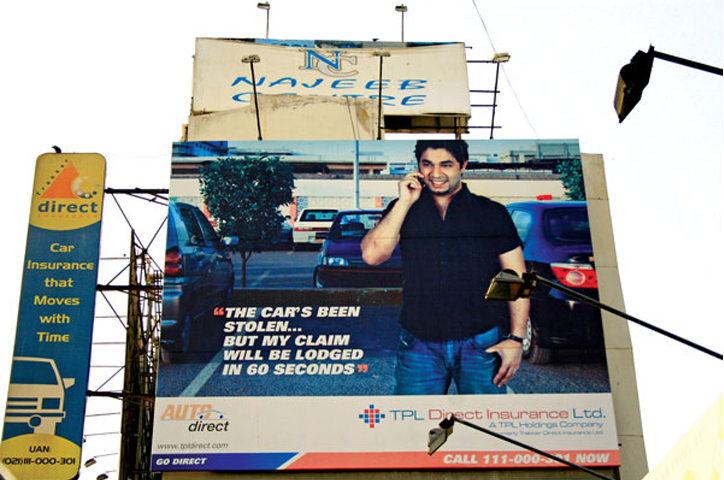A move to measure outdoors
Published in Jul-Aug 2014
Outdoor media has long been the subject of debate in Pakistan due to the fact that despite the heavy costs associated with it, there was no way to measure the effectiveness of the medium. Now, the Pakistan Advertisers Society (PAS) – which introduced the Peoplemeters TV ratings in Pakistan in 2007 – has decided to do something about this by launching the OOH Audience Measurement and Ratings project.
In October last year, the PAS set up a joint industry committee known as the Outdoor Audience Measurement Technical Committee (OAMTC) with 33 representatives from advertisers, media owners and media buying houses, and invited research agencies to bid for the project. The OAMTC received bids from six agencies (IPSOS, Markematics, MOVE, OAA, Oasis Kantar and South African based agency ODEX) and has selected MOVE for the project.
Established in Lahore in May 2013, MOVE is headed by Ali Hamdani who previously worked at Telenor and PepsiCo. MOVE did not pitch in isolation and the proposal was put forward in association with three other companies – which now form the MOVE Consortium. They include Cuende Infometrics, a Spanish company that specialises in marketing and advertising research and which has an exclusive partnership with the commercial satellite service provider, Digital Globe; Telmar, a UK based supplier of media advertising software and services used for reach, frequency and optimisation, and the Pakistan-based research agency TNS-Aftab which has expertise in field research.
Qamar Abbas, Executive Director, PAS, says that the decision to award the project to the MOVE Consortium was based on “the methodology, the technology, the software and the cost solutions they presented.”
The OOH Audience Measurement and Ratings project will initially cover Karachi, Lahore, Islamabad and Rawalpindi as, according to Hamdani they account for 75% of OOH investment in Pakistan.
The methodology aspect of the ratings will involve four research parameters: Traffic Count, Travel Survey, Site Classification and Visibility Adjustment Factor. The information collected from these metrics will determine the reach, frequency and ratings for each billboard.
Traffic Count (conducted by Digital Globe) will determine how many pedestrians and vehicles use a given route and is measured in two ways: satellite imaging and the installation of cameras in specific areas (installed by MOVE). This forms the ‘technology’ portion of the ratings. This information will be supplemented by the Travel Survey, an on-ground research conducted by TNS-Aftab. Based on 4,000 face-to-face interviews, 8,000 telephone interviews, supplemented by 500 GPS based samples and travel diaries kept by individuals, the Travel Survey will determine people’s travel habits and patterns, their mode of transportation, frequency of travel and destinations on different days.
These people-based parameters will be combined with Site Classification (conducted by MOVE), a process whereby each billboard in the four cities is listed and profiled according to its owner(s) as well as geographically, with longitude and latitude positions. Furthermore, a Visibility Adjustment Factor (a scientific process to reduce high visibility numbers by applying physical factors like size of the billboard, distance from the curb, etc.) will be applied to the research.
All the data and research will be fed into a software called Quantum (provided by Telmar and Cuende) in order to arrive at the ratings data. Hamdani says the process is likely to be completed by November 2014, after which a three-month demonstration period will begin. Once the data and system has been checked for bugs, further refined and makes the grade with the OAMTC, it will be declared the official currency for OOH ratings in Pakistan.
However the challenge lies in convincing the billboard owners to buy into this because, similar to the Peoplemeter ratings for TV which are paid for by the TV networks, the lion’s share of payment for the OOH ratings will have to come from billboard owners at a rate equivalent to 2.5% of the billboard owner’s annual turnover or total invoicing. (Advertisers pay 0.25% of their annual spend on billboard advertising and agencies 0.25% of their total invoicing.)
The PAS is well aware that convincing outdoor media owners to pay for the ratings is going to be difficult and that they are unlikely to be receptive to any attempt to introduce an organised system of ratings. This is further complicated by the fact that a single billboard can sometimes have more than one owner, thus making the task of billing very complex.
The solution, says Abbas, is a payment method that is advertiser-driven. This means that MOVE will charge advertisers three percent for the OOH ratings and they in turn will deduct this percentage at the time of settling their invoices with billboard agencies and media owners.
Although this system of ‘forced’ invoicing could create some thorny situations for advertisers in the future, Abbas is convinced that the benefits of having OOH ratings will outweigh the difficulties.
“Not only will the OOH ratings inform advertisers how efficient and effective their investment is, it will help achieve scientifically researched media planning as opposed to going with gut feel. The ratings will help to benchmark and standardise billboard sites’ tariffs and lead to greater accountability with respect to the advertisers’ investment. Eventually we will have a situation where ad spend in OOH will increase because advertisers will be more comfortable investing in it.”


Comments (0) Closed